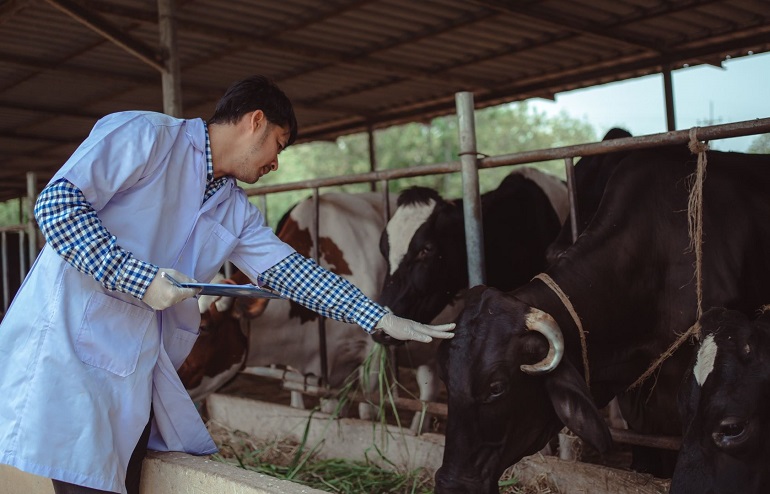AgTech innovations in Livestock Production

This post is also available in:
This post is also available in:
![]() Español (Spanish)
Español (Spanish) ![]() Français (French)
Français (French) ![]() Ελληνικά (Greek)
Ελληνικά (Greek)
Modern technology has been changing human lives for decades. Some of these technologies made their way to crop farming years ago as “precision ag” and are now showing up in livestock farming as general “ag technology” or “ag tech.” These developments are helping farmers do things they never dreamed possible, even 10 years ago, and gave birth to a new segment of the industry for careers in ag-tech.
Just as GPS, cell phone apps, and artificial intelligence help us manage our schedules and live our lives, technology is assisting livestock farmers and ranchers in managing their operations and enhancing the lives of their animals.
Agtech tailored to the livestock industry helps farmers operate their businesses with fewer employees in a tight labor market, improve the health of their animals, increase production using fewer resources, and make wiser financial and economic decisions for the farm.
Agtech Sensors in Livestock Production
Sensors are a common ag tech application that has been used for many years. A sensor is a device that records and collects data for interpretation by a human or a machine. The data can then be processed and analyzed and made useful through software and apps.
Examples include:
- Robotic milking and feeding systems.
- Camera and vision sensors.
- Infrared thermal imaging sensors.
- Temperature sensors.
- RFID tags.
- Motion sensors.
- Pedometers.
- Facial recognition machine sensors.
They are generally categorized as either invasive or non-invasive.
Electronic ear tags are a widespread livestock ag-tech development and have been around for decades now. But what is new is what is being done with them. They have been coupled with external sensors around the farm to monitor cow behavior. This is then interpreted by cutting-edge software so farmers can make informed decisions.
Most notably, these sensors allow for 24/7 monitoring beyond human ability and tracking that is often not available through visual observations. Among the important data collected are rumination and eating timing, activity and inactivity and location, blood pressure, heart rate, digestion, and respiratory.
Another example of this is air sensors in the poultry industry that can now predict the onset of coccidiosis. This intestinal infection can spread quickly among birds without any apparent symptoms.
This works because the diseases can be detected via air quality. The concentration of volatile organic compounds in the air increases as the number of infected birds increases. Air sensors can detect this change much earlier than a farmer or veterinarian could. The alerted farmers can then take timely measures to prevent the further spread of the infection. Such a system saves several animal lives and prevents financial losses.
In yet another example, studies show that infected pigs move less, by up to 10%, during the first two days of infection. Monitoring this behavioral change can be used to isolate infected animals before they infect many more animals.
Mobile Devices and Apps for AgTech
Among the latest ag-tech developments are apps for mobile devices that allow farmers to know what is happening wherever they are. Many of these are comprehensive software and hardware systems components that marry sensor and camera information via the internet of things or IoT.
Convenient apps for mobile devices bring all of this information directly to a convenient dashboard for the farmer to evaluate and make decisions. Some of these functions include regulating the climate in barns and evaluating carbon dioxide, ammonia, temperature, humidity, and illuminance.
Apps can also unify the on-farm team for more uniform livestock management. SwineTech is one such platform that helps managers ensure protocols are being adhered to and that there is good communication across the team to prevent serious issues.
Widespread use of mobile devices with internet connectivity, camera capabilities, and much more has already changed the landscape of livestock production. Industry experts believe this trend will continue with even more applications such as “telemedicine” or synchronizing data with far away veterinarians and other animal health professionals to make real-time decisions for the herd.
Drones and Wireless Systems for “smart” livestock farming
Livestock farmers are using drones to help them efficiently and easily access hard-to-reach places. Drones allow them to check feeders, water troughs, fence lines, and animal behaviors, so they can spot potential issues and nip them in the bud before they become bigger problems. For example, drones can help a livestock farmer track movement to spot lethargic animals who may need help. Drones equipped with thermal imagery can be used to check body temperatures, which is another proactive way of detecting illness or infection in the herd. There are also discussions about drones being used to move herd animals in the same manner as dogs do now.
Similar to drones, wireless ag-tech servers, and programs, are also enabling farmers to monitor and control different aspects of their operations remotely.
InTouch, for example, is able to upgrade a traditional mounted feed mixer wagon to a wireless, remotely monitored system so a farmer can remotely measure all the feed ingredients that go in and out of the wagon.
Other wireless livestock ag-tech products include high-end environmental monitors, which will alert the farm managers to changes in the barn’s climate and air quality. There are also developments to make this kind of technology accessible in other applications, such as electric fencing, so that farmers can be notified of any outages by a phone alert.
Data and Artificial Intelligence in livestock farming
Animal agriculture has been collecting data for decades via various software. In fact, there is so much information livestock producers could lose crucial metrics in a sea of information.
Ag-tech data needs to be massaged, sorted, and interpreted correctly to be useful to the farm. Having systems in place to do the heavy number crunching not only advises farm operators on making informed decisions but also allows them to see where we might be missing information that needs to be collected.
Students at the South Dakota School of Mines and Technology (SDSMT) are at work using data and AI to develop a tool to help ranchers predict cattle market trends and make optimal business decisions for the farm. This project involves harnessing a wealth of data not often used in previous predictions, including electricity, fuel, vaccines, and more.
New ag-tech companies are popping up that think along the same lines. Some programs measure everything in an animal’s life to determine a value for sales, an important source of revenue for livestock farmers and ranchers.
In practice, these advanced technologies can be used to determine optimal solutions to many animal farming problems. A few examples include finding optimal solutions to minimize costs, maximize production, increase efficiencies, and create optimal diet formulations.
This has led to the ability of advanced technologies to forecast and predict outcomes of economic importance, such as body weight, milk yield, or egg production.
AI systems can determine the accuracy of fertility in the early stage of incubation. AI can first learn which eggs are fertile and which are not by scanning the eggs, and then algorithms can be created to determine fertility accuracy.
The Future of AgTech and Livestock
Some have called ag-tech livestock farming animal agriculture’s version of the fourth Industrial Revolution. Agriculture companies, researchers, and even farmers are coming together for events hosted around the globe to showcase their latest wares, share ideas, and learn how to improve lives for farmers of all sizes and backgrounds.
In this fast-paced world, new technology is continually being dreamed of and developed. Livestock farmers and ranchers who embrace it will find new ways of doing the work they love.
References
- https://www.agriculture.com/livestock/cattle/dairy/4-tech-innovations-f-dairy-operations_278-ar50693
- https://www.agriculture.com/technology/livestock/five-animal-agriculture-entrepreneurs-from-the-alltech-start-up-program
- https://www.agriculture.com/technology/livestock/hardware/beef-producers-me-tech-coming_593-ar45329
- https://www.agriculture.com/technology/livestock/students-reimagine-rancher-s-30-year-old-cattle-market-prediction-model
- https://www.agriculture.com/technology/livestock/five-animal-agriculture-entrepreneurs-from-the-alltech-start-up-program
- https://www.sciencedirect.com/science/article/pii/S2214180420301343
Livestock AgTech to Improve Sustainability
AgTech innovations in Livestock Production








































































